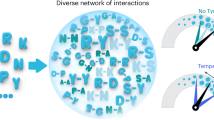Abstract
Nanometre- and micrometre-sized charged particles at aqueous interfaces are typically stabilized by a repulsive Coulomb interaction. If one of the phases forming the interface is a nonpolar substance (such as air or oil) that cannot sustain a charge, the particles will exhibit long-ranged dipolar repulsion1; if the interface area is confined, mutual repulsion between the particles can induce ordering2 and even crystallization3,4. However, particle ordering has also been observed in the absence of area confinement5, suggesting that like-charged particles at interfaces can also experience attractive interactions6. Interface deformations are known to cause capillary forces that attract neighbouring particles to each other, but a satisfying explanation for the origin of such distortions remains outstanding7,8. Here we present quantitative measurements of attractive interactions between colloidal particles at an oil–water interface and show that the attraction can be explained by capillary forces that arise from a distortion of the interface shape that is due to electrostatic stresses caused by the particles' dipolar field. This explanation, which is consistent with all reports on interfacial particle ordering so far, also suggests that the attractive interactions might be controllable: by tuning the polarity of one of the interfacial fluids, it should be possible to adjust the electrostatic stresses of the system and hence the interparticle attractions.
This is a preview of subscription content, access via your institution
Access options
Subscribe to this journal
Receive 51 print issues and online access
$199.00 per year
only $3.90 per issue
Buy this article
- Purchase on Springer Link
- Instant access to full article PDF
Prices may be subject to local taxes which are calculated during checkout




Similar content being viewed by others
References
Pieranski, P. Two-dimensional interfacial colloidal crystals. Phys. Rev. Lett. 45, 569–572 (1980)
Onada, G. Y. Direct observation of two-dimensional, dynamical clustering and ordering with colloids. Phys. Rev. Lett. 55, 226–229 (1985)
Denkov, N. D., Velev, O. D., Kralchevsky, P. A. & Ivanov, I. B. Two-dimensional crystallization. Nature 361, 26 (1993)
Wickmann, H. H. & Korley, J. N. Colloid crystal self-organization and dynamics at the air/water interface. Nature 393, 445–447 (1998)
Ruiz-García, J., Gámez-Corrales, R. & Ivlev, B. I. Formation of two-dimensional colloidal voids, soap froths, and clusters. Phys. Rev. E 58, 660–663 (1998)
Quesada-Pérez, M., Moncho-Jordá, A., Martínez-López, F. & Hidalgo-Álvarez, R. Probing interaction forces in colloidal monolayers: Inversion of structural data. J. Chem. Phys. 115, 10897–10902 (2001)
Kralchevsky, P. A. & Denkov, N. D. Capillary forces and structuring in layers of colloid particles. Curr. Opin. Colloid Interf. Sci. 6, 383–401 (2001)
Stamou, D., Duschl, C. & Johannsmann, D. Long-range attraction between colloidal spheres at the air-water interface: The consequence of an irregular meniscus. Phys. Rev. E 62, 5263–5272 (2000).
Hurd, A. J. The electrostatic interaction between interfacial colloidal particles. J. Phys. A 18, L1055–L1060 (1985)
Chan, D. Y. C., Henry, J. D. & White, L. R. The interaction of colloidal particles collected at fluid interfaces. J. Colloid Interf. Sci. 79, 410–418 (1981)
Kralchevsky, P. A., Paunov, V. N., Ivanov, I. B. & Nagayama, K. Capillary meniscus interaction between colloidal particles attached to a liquid-fluid interface. J. Colloid Interf. Sci. 151, 79–94 (1992)
Morse, D. C. & Witten, T. A. Droplet elasticity in weakly compressed emulsions. Europhys. Lett. 22, 549–555 (1993)
Bowden, N., Terfort, A., Carbeck, J. & Whitesides, G. M. Self-assembly of mesoscale objects into ordered two-dimensional arrays. Science 276, 233–235 (1997)
Kralchevsky, P. A. & Nagayama, K. Capillary interactions between particles bound to interfaces, liquid films and biomembranes. Adv. Colloid Interf. Sci. 85, 145–192 (2000)
Goulian, M., Bruinsma, R. & Pincus, P. Long-range forces in heterogeneous fluid membranes. Europhys. Lett. 22, 145–150 (1993)
Golestanian, R., Goulian, M. & Kardar, M. Fluctuation-induced interactions between rods on a membrane. Phys. Rev. E 54, 6725–6734 (1996)
Landau, L. D. & Lifshitz, E. M. Electrodynamics of Continuous Media (Addison Wesley Publishing, Pergamon Press, Reading, MA, 1964)
Berge, B. Electrocapillarity and wetting of insulator films by water. C. R. Acad. Sci. II 317 2, 157–163 (1993)
Russel, W. B., Saville, D. A. & Schowalter, W. Colloidal Dispersions (Cambridge Univ. Press, Cambridge, UK, 1989)
Aveyard, R. et al. Measurement of long-range repulsive forces between charged particles at an oil-water interface. Phys. Rev. Lett. 88, 246102-1-4 (2002)
Pusey, P. N. & van Megen, W. Phase-behaviour of concentrated suspensions of nearly hard colloidal spheres. Nature 320, 340–342 (1986)
Crocker, J. C. & Grier, D. G. Methods of digital microscopy for colloidal studies. J. Colloid Interf. Sci. 179, 298–310 (1996)
Acknowledgements
We thank B. Berge and T. M. Squires for discussions. We gratefully acknowledge support from the NSF, the Materials Research Science and Engineering Center through the auspices of the NSF and the Division of Mathematical Sciences. A.B. acknowledges the support from the Emmy Noether-Program of the DFG.
Author information
Authors and Affiliations
Corresponding author
Ethics declarations
Competing interests
The authors declare that they have no competing financial interests.
Rights and permissions
About this article
Cite this article
Nikolaides, M., Bausch, A., Hsu, M. et al. Electric-field-induced capillary attraction between like-charged particles at liquid interfaces. Nature 420, 299–301 (2002). https://doi.org/10.1038/nature01113
Received:
Accepted:
Issue Date:
DOI: https://doi.org/10.1038/nature01113
This article is cited by
-
Single-particle tracking of the formation of a pseudoequilibrium state prior to charged microgel cluster formation at interfaces
NPG Asia Materials (2020)
-
In situ X-ray scattering observation of two-dimensional interfacial colloidal crystallization
Nature Communications (2018)
-
Dynamic capillary assembly of colloids at interfaces with 10,000g accelerations
Nature Communications (2018)
-
Centrifugation-assisted Assembly of Colloidal Silica into Crack-Free and Transferrable Films with Tunable Crystalline Structures
Scientific Reports (2015)
-
Silver(I)-directed growth of metal-organic complex nanocrystals with bidentate ligands of hydroquinine anthraquinone-1,4-diyl diethers as linkers at the water-chloroform interface
Nanoscale Research Letters (2014)
Comments
By submitting a comment you agree to abide by our Terms and Community Guidelines. If you find something abusive or that does not comply with our terms or guidelines please flag it as inappropriate.



